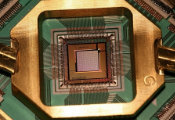LANL and D-Wave Researchers Discover New Insights into Quantum Fluctuations and Ordered States
Feb. 2, 2024 — Experimental research conducted by a joint team from Los Alamos National Laboratory and D-Wave Quantum Systems examines the paradoxical role of fluctuations in inducing magnetic ordering on a network of qubits. Using a D-Wave quantum annealing platform, the team found that fluctuations can lower the total energy of the interacting magnetic moments, an understanding that may help to reduce the cost of quantum processing in devices.
A cropped representation of two configurations of the asymmetric hexagonal lattice the researchers studied, with strong antiferromagnetic couplings shown along parallel lines and weaker diagonal couplings illustrated as dashed lines. Each red or blue arrow represents a logical qubit hosting a magnetic moment oriented either upwards or downwards. The two configurations have the same internal energy but different entropy as a result of the floppy qubit — shown here as a green dot — which has an undetermined orientation for the qubit magnetic moment.
“In this research, rather than focusing on the pursuit of superior quantum computer performance over classical counterparts, we aimed at exploiting a dense network of interconnected qubits to observe and understand quantum behavior,” said Alejandro Lopez-Bezanilla, a physicist in the Theoretical division at Los Alamos.
As described in Nature Communications, the team investigated the complex interplay of approximately 2,000 qubits within an asymmetric hexagonal lattice. They explored the impact of factors that typically induce disorder on magnetic moments — the small magnetic field created by the superconducting qubits.
The team introduced fluctuations, signifying dynamic changes in the alignment and arrangement of magnetic moments, which were driven by both thermal effects, associated with temperature, and quantum effects, resulting from the application of an external magnetic field. That allowed them to experiment with entropy, magnetic moments and disorder on the “frustrated” magnetic lattice they’d designed.
The results proved a counterintuitive argument: Under some physical conditions, configurations with a clustered distribution of defects emerge as the more likely state, challenging conventional assumptions about the relationship between disorder and entropy. If the prevailing expectation is that configurations with higher entropy should exhibit greater disorder, the team was able to demonstrate in a quantum system that ordered states characterized by specific patterns can emerge, akin to the “order by disorder” process, even when seemingly disorder-inducing factors are present.
“The idea that we could promote order by adding thermal fluctuations and even enhance it by adding quantum fluctuations may seem paradoxical,” said Cristiano Nisoli, Laboratory physicist and a co-author of the study. “But we’ve been able to observe in detail how fluctuations influence the mechanisms and physical conditions leading to defect clustering. That insight can point us to improvements in the way quantum systems are built.”
In the future, additional developments of the D-Wave quantum platform and experimental capabilities will allow researchers to focus uniquely on the role of quantum fluctuations, disentangling them from the concurrent influence of thermal fluctuations.




































